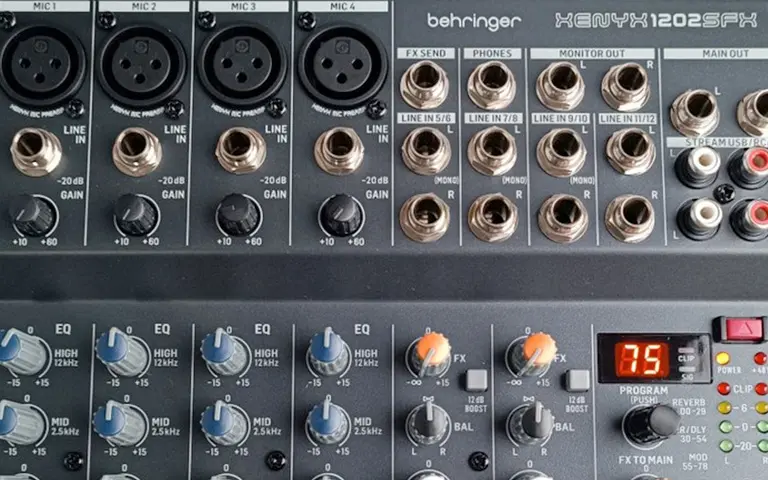
Business podcasters looking for a mixer may be interested in the Behringer XENYX series. These analog interfaces are less cluttered than more advanced digital tools, yet provide all the essential utility needed for basic podcast recording applications. To get a complete picture of how the Behringer XENYX ranks among the industry’s best, check out our curated list of the best podcast mixers here.
There are two popular models of Behringer XENYX: the 12 channel 4 XLR input (the 1202SFX), and the 8 channel 2 XLR input (the 802S). We’re going to cover both of these below so you can determine which one makes the most sense for your podcast. If neither of these models make the cut, we introduce some alternatives that may be a better fit.
Let’s get started.
- Behringer XENYX at a glance
- Behringer XENYX features
- What’s the difference between the 802S and 1202SFX?
- Behringer XENYX hardware
- How to use a Behringer XENYX
- Alternatives to the Behringer XENYX series
- The bottom line on the Behringer XENYX
Behringer XENYX at a glance
Would a Behringer XENYX mixer be a good fit for your podcast?
You can use this chart to get a better idea:
| Recording Media | USB Connector | Sampling Rate | Recording Format | Microphone Inputs | Included Items | Price | |
| 1202SFX | You must connect to an external device | USB Type-B | 48kHz / 16bit | 24-bit / 48kHz WAV | 4 | The mixer, the user manual, the power adapter | $139.99 USD |
| 802S | You must connect to an external device | USB Type-B | 48kHz / 16bit | 24-bit / 48kHz WAV | 2 | The mixer, the user manual, the power adapter, the USB cable | $89.00 USD |
Let’s examine these features in greater detail.
Behringer XENYX features
As mentioned, we’re covering two different XENYX products in this review: the 802S, and the 1202SFX. Both of these products are analog mixers, which means while they are less configurable and can’t be automated in the same way as digital mixers, they offer a sturdy and simplified hands-on workflow (like a few other top podcast mixers).
The biggest difference between the two mixers is the number of mic inputs they have. The 802S has two XLR inputs, while the 1202SFX has four.
We cover some additional differences later in our guide.
Let’s look at a few key features of each:
Behringer XENYX 802S
- Two mics: These are both XLR inputs so you’ll need to use XLR microphones or an adapter to connect to the mixer.
- Phantom power: You can switch on 48 volts of phantom power whenever necessary. This means you can use dynamic and condenser microphones.
- Gain knob: You can boost your input levels by +60dB, which is helpful if you’re using mics with low volume input (so you can get to optimal recording volumes).
- FX send: This allows you to record remote guests with the help of an aux cable. Keep in mind this cable must be purchased separately.
- Three-band EQs: You can alter the highs, mids, and lows of your audio directly on the mixer. There’s also a single-knob compression tool that can help improve an overly dynamic mix.
- One headphone jack: One member of your podcast can listen to the audio mix. The other guest, unfortunately, cannot.
XENYX 1202SFX
- Four mics: You have four mic inputs with XLR inputs. You also have four 1/4 inch inputs for line-level signals.
- Phantom power: Like the 802S, you can use dynamic or condenser microphones with this mixer. You only power either all mics at once or none at all.
- Gain knob: You can boost your input levels by +60dB. A clip LED flashes if you overdrive the input.
- Three-band EQs: Adjust the highs, mids, and lows of your sound for each of the four inputs. The EQ is shelved at 12kHz, 2.5kHz, and 80kHz respectively.
- +4 -10 switches: These are designed to match levels with the input signal, if needed. There is one of these switches for each stereo input.
- FX processor: This knob includes more than 100 presets, including reverb, chorus, and more. You can also control the amount of effect in your mix by turning the FX to Main knob.
- Master fader: You can quickly adjust the volume of your output audio mix.
- FX send: This allows you to send the channel to an optional outboard effects processor. Just be prepared to purchase this cable separately (if you don’t already own one).
- One headphone jack: The single jack is enough for one person to monitor your mix. It also means individual guests can’t hear their own audio while recording an episode.
Keep in mind pan, balance, and level controls are included with all units.
You can also visit behringer.com to download firmware, software, and manuals for each.
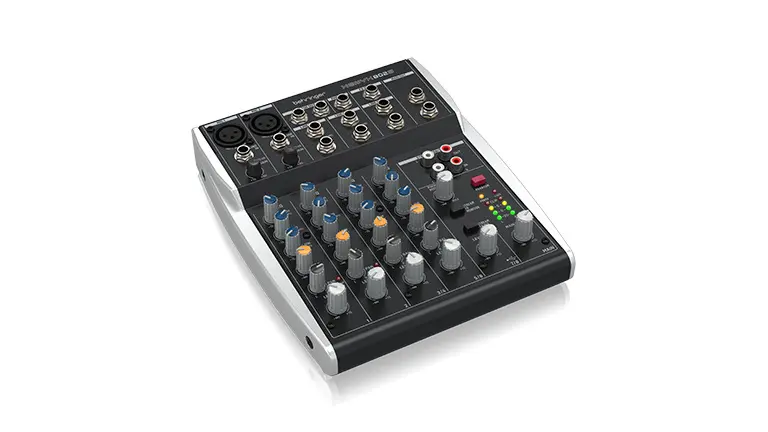
802S pros
- All connections and controls are easily accessible on the face of the mixer (except for the power adapter outlet).
- The +60dB of gain can enhance a variety of mics.
- The presence of phantom power makes it easy to record with dynamic or condenser microphones.
802S cons
- Since the 802S wasn’t specifically designed for podcasters, it may come with features you don’t specifically need (like speaker outputs for live music).
- There is no on/off button, so the device is always functional when plugged into a power source.
- Your LED clip and monitor lights may not offer much granularity. You only have lights for -20dB, 0dB, +6dB, and audio clipping.
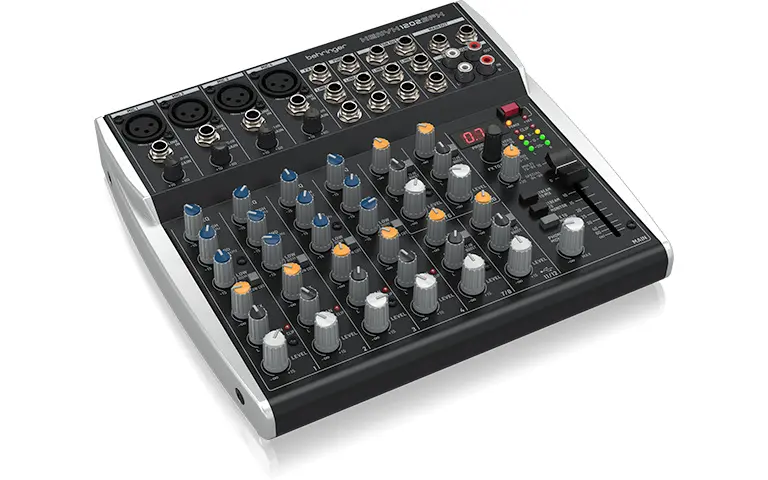
1202SFX pros
- Like the 802S, you can access all plug-ins and controls (other than the power adapter) on the front of the device.
- You get +60dB of gain, which like the 802S, enhances even lower-quality mics.
- Optional phantom power allows you to mix and match your microphones.
1202SFX cons
- Like the 802S, there’s no on/off switch.
- There’s only one headphone jack on the 1202SFX.
- Because this mixer isn’t specifically designed for podcasting, you may be paying for features you don’t need.
What’s the difference between the 802S and 1202SFX?
As mentioned earlier, the 802S has two mic inputs, while the 1202SFX has four.
However, there are a few other differences to keep in mind:
| Channels | Master Fader | Preset SFX | |
| 802S | 8 | ❌ | ❌ |
| 1202SFX | 12 | ✔️ | ✔️ |
There is one major similarity to keep in mind — both of these mixers are analog devices. This means they need external recording devices (like your phone or computer) to capture audio.
Behringer XENYX hardware
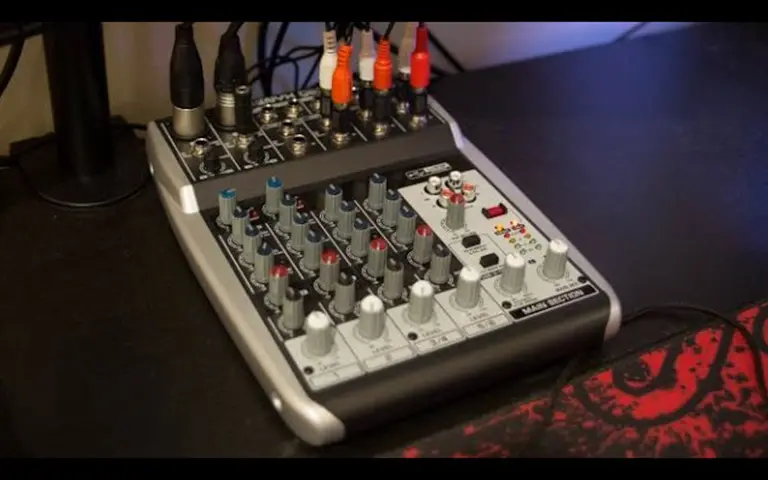
In order to remain at a lower price point, XENYX mixers don’t come with much in the box.
With the 802S, you get:
- The mixer itself
- The user manual
- The power adapter
You get similar items with the 1202SFX:
- The mixer itself
- The user manual
- The power adapter
- The USB cable
You need to purchase compatible microphones before powering on your XENYX mixer.

How to use a Behringer XENYX
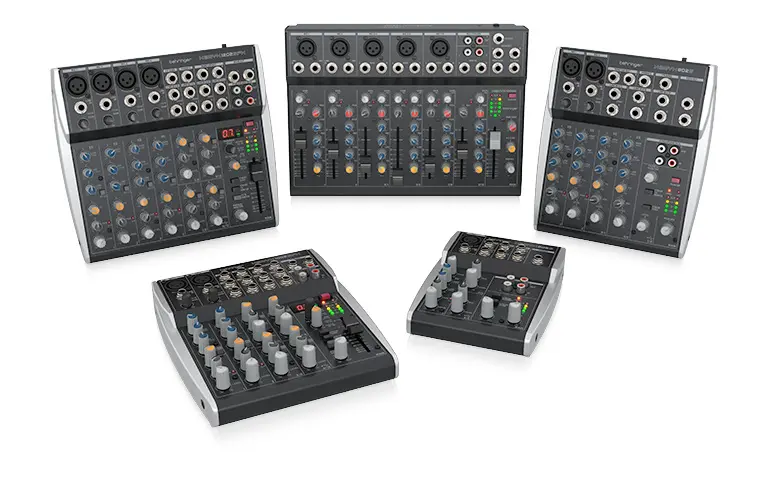
Regardless of the Behringer XENYX product you choose, the setup process remains relatively the same.
There are 10 basic steps to start recording with your XENYX:
- Plug in your device using the power adapter.
- Set all your knobs and faders to the neutral position.
- Plug in your mic(s) and turn on phantom power (if necessary).
- Connect your headphones and adjust gain and EQ as necessary.
- If you have a 1202SFX, add SFX if desired.
- Add your call-in guest via the aux cord (if necessary).
- Connect a USB cable from the mixer to your recording device.
- Pull up your recording software and configure the input to your liking.
- You should be ready to hit record on your external device.
- Get ready to edit, enrich, and promote your podcast episode.
You’re welcome to watch this guide to setting up the 802S:
You can also watch this setup video of the 1202SFX:
Alternatives to the Behringer XENYX series
If the Behringer XENYX series doesn’t offer what you need, we recommend trying one of these similar alternatives:
Maonocaster
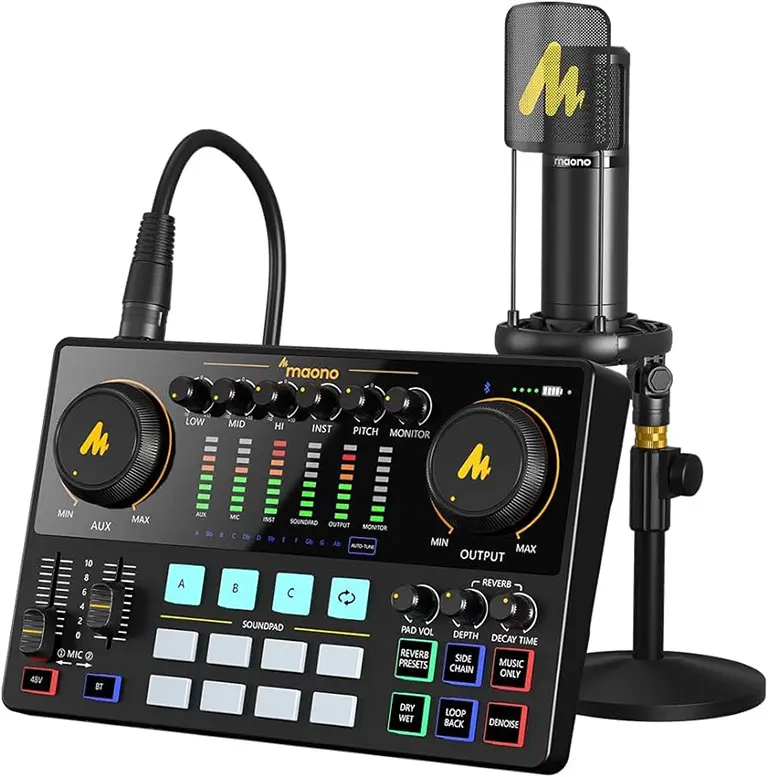
Maonocaster offers similar mixers to the 802S and the 1202SFX. We recommend two different models: the Lite, and the E2.
Neither of these mixers record audio on-device, which makes them similar to Behringer XENYX. However, there are several unique upgrades to keep in mind. The Lite offers soundpads and a Bluetooth connection, while the E2 offers two separate headphone outputs.
You can check the full breakdown in this handy guide.
TASCAM Mixcast 4
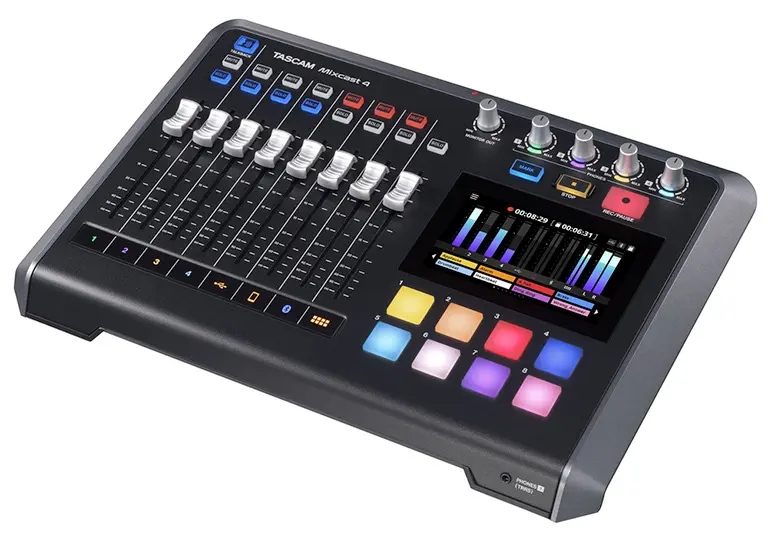
The TASCAM Mixcast 4 is a full-featured mixer designed for large or complex podcast productions. In addition to the four XLR inputs and LCD touchscreen, you can connect remote call-ins and directly record audio on SD, SDHC, and SDXC cards.
Just keep in mind these extra features do come at a cost. The TASCAM Mixcast 4 is roughly four times the price of the Behringer XENYX 802S.
You can read our full guide to get more of these specifics.
ZOOM PodTrak P8
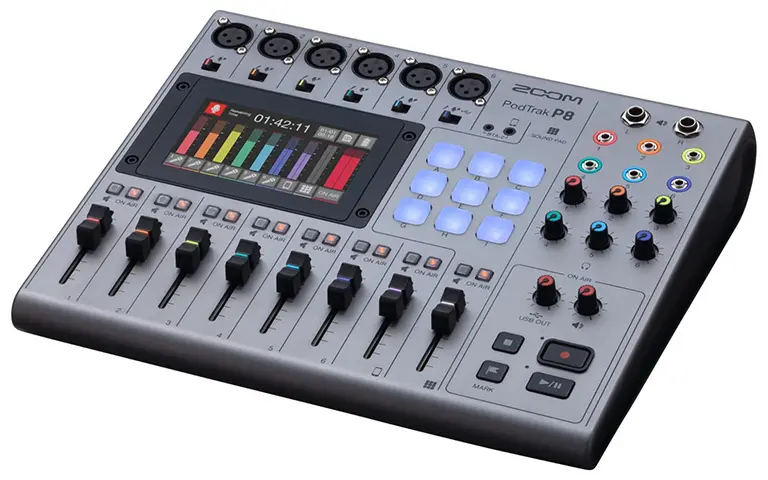
The ZOOM PodTrak P8 provides several features you can’t get with a Behringer XENYX. You can customize nine soundpads with four sound ‘banks,’ connect your phone via Bluetooth connection, and use built-in editing tools to create rough cuts without editing software.
But again, keep in mind this comes at a steep price. This is by far the most expensive alternative to either of the Behringer XENYX mixers.
Want to learn more about the PodTrak P8’s features? Check out our full guide and breakdown comparison.
Mackie ProFX
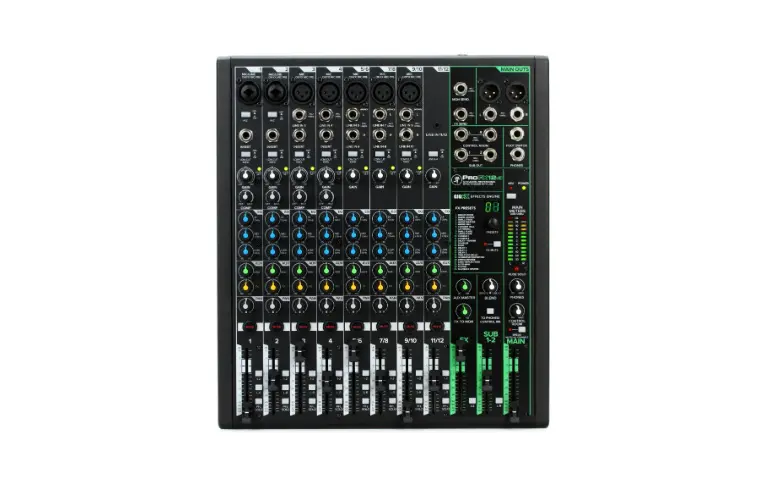
The Mackie ProFX12v3 and ProFX6v3 are two viable alternatives to Behringer XENYX mixers. Each rely on USB type B connectors to capture 192kHz / 24-bit audio in the bundled digital audio workstation (DAW).
There are a few crucial differences to keep in mind. The 12v3 mixer comes with seven microphone inputs while the 6v3 comes with two. There’s also no aux channel on the 6v3, which may be a dealbreaker for some podcasters.
Our guide to Mackie ProFX mixers covers this in greater detail.
PreSonus StudioLive AR8
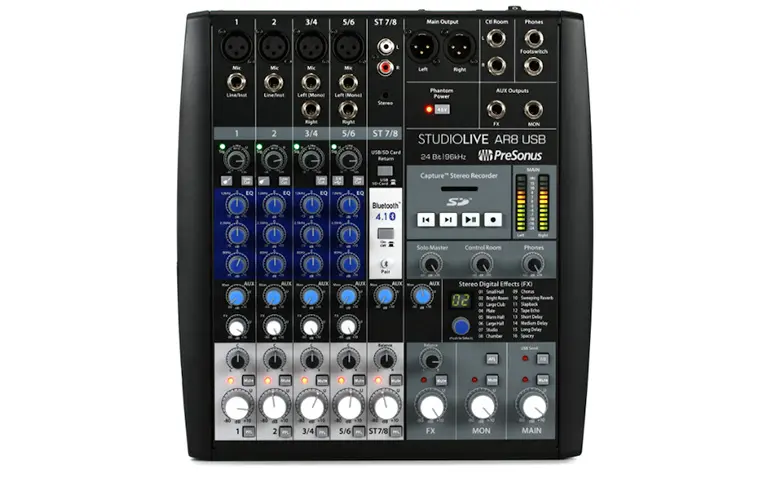
The PreSonus StudioLive AR8 is a hybrid mixer/audio interface for both livestreaming and prerecording podcasts. You can record audio directly to an SD card, or connect with your computer to record with PreSonus Capture software. There’s also Bluetooth 4.1 functionality for streaming music pre-show.
Just keep in mind this is a discontinued mixer — you can’t buy new products directly from the PreSonus site. If you’re still interested in testing this product, our guide explains where to find gently used PreSonus StudioLive AR8 mixers.
The bottom line on the Behringer XENYX
Behringer XENYX mixers are cost-effective options for podcasters on a budget. As long as you have a few microphones on hand, you can record quality audio in a few hours or less.
But as you upgrade the equipment of your growing podcast, don’t forget to consider some operational upgrades as well. It may be time to delegate certain tasks to professionals, like getting audio production and remote recording services from the team at The Podcast Consultant.
We’re proud to work with brands big and small in the development, edit, and launch of successful shows. We also perform audits of existing podcasts to identify opportunities for growth and improvement.
Ready to learn more about how we can help? Book a discovery call with TPC today.